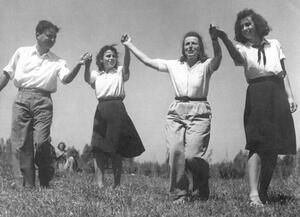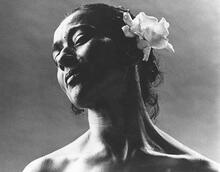Gurit Kadman
After moving to Tel Aviv in 1931, Kadman taught dance and gymnastics at several schools, founded Shalva, a progressive school, in the early 1940s, and taught international and Israeli folk dancing at the Teachers’ Seminary. In 1944 she choreographed a pageant at Kibbutz Daliyyah, sparking interest in a dance festival at the kibbutz. She encouraged choreographers to create hundreds of new Israeli dances that reflected a love of the land and put on festivals in 1947, 1951, 1958, and 1968. In 1945 Kadman founded the dance department of the Histradut, the core of the Israeli folk dance movement. Kadman ran dance workshops in America, Africa, and Asia, as well as displaced persons camps of Holocaust survivors in Europe. She published two books on dance and was awarded the Israel Prize in 1981 for her contributions to Israeli culture.
Family History
Gurit Kadman was born Gertrude (Gert) Loewenstein, the oldest of three siblings, with a brother, Heinrich (Heinz) and a sister, Kattee. Her married name was Gert Kaufman. With the establishment of the State of Israel in 1948, the family changed its name to Kadman and Gert changed her first name to Gurit. She was born on March 3, 1897 in Leipzig, Germany, and died in Jerusalem in 1987. Her father, Dr. Berthold Loewenstein, a lawyer, was born in 1864 in Hanover and died in 1946 in Tel Aviv. Berthold’s mother was one of two daughters of the eminent German reform rabbi, Salomon Herxheimer (1801–1884), the provincial rabbi of Alhalt-Bernburg, who translated the Bible into German, published widely-read expositions on the principles of Judaism and introduced the Lit. "daughter of the commandment." A girl who has reached legal-religious maturity and is now obligated to fulfill the commandmentsbat mitzvah ritual. Gurit’s mother, Ida Eckstein, was born in 1875 in Goettingen, Germany and died in 1943 in Tel Aviv. Ida’s mother, Henrietta, wrote and published a family chronicle. This and another family history, published in 1922, traced three hundred years of family history, beginning in Prague in 1545 with an account of the life of Jacob Bassevi (1570–1634). During the Thirty Years’ War, Bassevi distinguished himself as financial advisor and army factor for Ferdinand II. He was awarded a title of nobility, Bassevi Von Treuenberg. When his beloved wife Handel died at an early age in 1628, Bassevi commissioned an elaborate tombstone to mark her grave. The tombstone may still be seen in the old Jewish cemetery of Prague.
Early Zionist Interest
As a teenager, Kadman was attracted to nature and folklore. She joined the German youth movement, Wandervogel (Wandering Bird), which sought out Germany’s cultural roots and folk expression. Her assimilated, upper-middle class family placed little emphasis on Jewish tradition and her Jewish religious education was perfunctory. At home, the family celebrated only the High Holidays and A seven-day festival to commemorate the Exodus from Egypt (eight days outside Israel) beginning on the 15th day of the Hebrew month of Nissan. Also called the "Festival of Mazzot"; the "Festival of Spring"; Pesah.Passover. Kadman’s interest in nature and folklore grew to include physical culture and dance. From this milieu there grew her attraction for nonconformist ideas—like her early feminism, her disregard for bourgeois social manners, her attraction to Zionism and particularly to the egalitarian pioneering ideals of the A voluntary collective community, mainly agricultural, in which there is no private wealth and which is responsible for all the needs of its members and their families.kibbutz.
In 1918, Kadman met a young Zionist, Leo Kaufman, at a family wedding and was captivated by his enthusiasm for a pioneering life in Palestine. Born in 1895 in Mulheim an der Ruhr, to a family of cattle and hide merchants, Leo Kaufman had served in the German army during World War I. Together, the couple joined the Blau Weiss youth movement and began agricultural training in preparation for a communal life in Palestine. They were married in 1919. A year later, together with their infant son, Raphael, they settled in Palestine and were among the founders of the communal settlement Hefzi-Bah. Their second son, Amnon, was born in 1922 at Hefzi-Bah’s temporary site in Haderah before the kibbutz moved to its permanent settlement in the Emek (the Valley of Jezreel).
Leo was active in the socialist Zionist movements Ha-Po’el ha-Za’ir, He-Halutz and the Gedud ha-Avodah and in 1925 was sent on an educational mission to Austria, where Ayalah, the couple’s daughter, was born. Soon after the family’s return to Palestine Leo was appointed a director of the newly established housing department of the Histadrut, the Jewish Labor Federation. The family left the kibbutz and in 1931 moved to their home in Tel Aviv.
Israeli Folk Dance
Throughout these years, Kadman had taught gymnastics and dance at several schools, including the Youth Village at Ben Shemen founded by Dr. Siegfrid Lehman, where she taught international folk dance. In the early 1940s, together with Mordekhay and Genya Vilensky, she founded the progressive school, Shalva, where she taught physical education and dance. She introduced the same subjects to the schools under the auspices of the Histadrut. Concurrently, she also taught international and Israeli folkdances at the Teachers’ Seminary of the kibbutz movement.
The year 1944 was a ground-breaking year in the history of Israeli folk dance and in the growing influence of Kadman. That summer, in collaboration with members of Kibbutz Daliyyah, she organized, staged and produced a pageant for the feast of Lit. "weeks." A one-day festival (two days outside Israel) held on the 6th day of the Hebrew month of Sivan (50 days, or 7 complete weeks, from the first day of Passover) to commemorate the Giving of the Torah on Mount Sinai; Pentecost; "Festival of the First Fruits"; "Festival of the Giving of the Torah"; Azeret (solemn assembly).Shavuot, Hag ha-Bikkurim, based on the book of Ruth. The success of the pageant became the incentive for organizing a folk dance festival at the kibbutz. Kadman was convinced that this was the opportunity to begin a major undertaking to correct the lack of indigenous Israeli dances—an initiative that which would reflect the return to the Land of Israel, to agriculture, and to biblical folk sources. There were a few individuals with dance and musical training in the A voluntary collective community, mainly agricultural, in which there is no private wealth and which is responsible for all the needs of its members and their families.kibbutzim who felt the need to create original dances and songs. Kadman encouraged them to create works for the holiday festivals and popular folk dances for festive communal events. In the years between the first Daliyyah festival (1944) and the second (1947), hundreds of new dances were created. So great was the interest that the second festival was held in an enormous natural amphitheater near the kibbutz. Kadman’s conviction that the Jews had been a “dancing people” since Biblical times was borne out. Her energy and charisma were contagious, and together with the effective organizational support of the members of Kibbutz Daliyyah three more festivals took place in this amphitheater, in 1951, in 1958, as part of Israel’s tenth anniversary celebration, and in 1968, when the last of the Daliyyah festivals marked the twentieth anniversary of Israel’s independence.
In 1945 Kadman founded the dance department of the Histadrut, which became the center of enormous activity, propelling the folk dance movement in Israel and abroad. The department established dance workshops and dance leaders’ training programs, and issued dance leaflets for holidays and special events. In 1947, in conjunction with the Jewish Education Committee and other agencies, Kadman went on a nation-wide tour of the United States to spread Israeli dance through dance workshops and seminars. In later years she toured Africa and the Far East.
Preserving Ethnic Dance
Especially noteworthy was Kadman’s direction of the folk dance ensemble that was part of the Israeli youth delegation to the First International Youth Festival, held in Prague in the summer of 1947. Following the festival, the ensemble toured DP camps in Czechoslovakia, Germany and Italy, performing and teaching the dances of The Land of IsraelErez Israel to the survivors of the Holocaust. All the while, Kadman invested much time and energy in the preservation and fostering of the dance traditions and festivities of the diverse ethnic groups in Israel, including the Arab sector and other minority groups. In 1971 she founded the Project for the Preservation and Revival of Ethnic Dance in Israel.
The influx of immigrants from around the world after the establishment of the State of Israel raised the danger that the dominant Western orientation might overwhelm the rich diversity of dance traditions brought by the immigrants. Kadman, who felt that the dances should be documented on film while they were still in their original form, at first single-handedly found the resources for this purpose. She initiated a second project: creating a great number of ethnic dance groups—Yemenite, Kurdish, Georgian, Indian, North African, Ethiopian, Bukharan, Arab, Circassians and others. For these achievements, she was awarded the Israel Prize in 1981, the highest award given by the State. With the help of the award money and additional contributions, she produced a book, Ethnic Dance In Israel (1982, Hebrew). Her first book, Am Roked (“A Dancing People”) was published in 1964.
Kadman was active in a number of international organizations of folk music and dance, lecturing extensively at conferences, where she presented her documentary films of the ethnic and folk dances of Israel. In the course of a half-century of creating a popular dance movement, Kadman published a vast and significant body of educational materials for dance leaders—pamphlets, records and handbooks.
Kadman, Gurit. Ethnic Dances in Israel (Hebrew). Givatayim: 1982.
A People Dances. The History of Ethnic Dance in Israel (Hebrew). Jerusalem, Tel Aviv: 1969.
Idem. “Yemenite Dances and Their Influence on the New Israeli Folk Dances.” Journal of International Folk Music Council 4 (1952): 27–30.
Kadman-Goren, Ayalah. “Ethnic Dance in Israel,” with selected filmography. Jewish Folklore and Ethnology 8/3–4 (1986):1–6.
Brin-Ingber, Judith. “Shorashim: The Roots of Israeli Folk Dance.” Dance Perspective 59 (Autumn 1974).
Manor, Giora. Sara’s Way: The Choreography Of Sara Levi-Tanai (Hebrew and English). Tel Aviv: 2001.
Bahat-Ratzon Naomi, ed. Barefoot: Jewish-Yemenite Tradition in Israeli Dance (Hebrew and English). Tel Aviv: 1999.
Bahat, Naomi and Avner. The Diwan Songs of the Jews of Central Yemen: Poetry, Music, Dance (Hebrew and English). Tel Aviv: 1995.
Friedhaber, Zvi. History of the Dance of the Jewish People (Hebrew). Tel Aviv: 1984.




